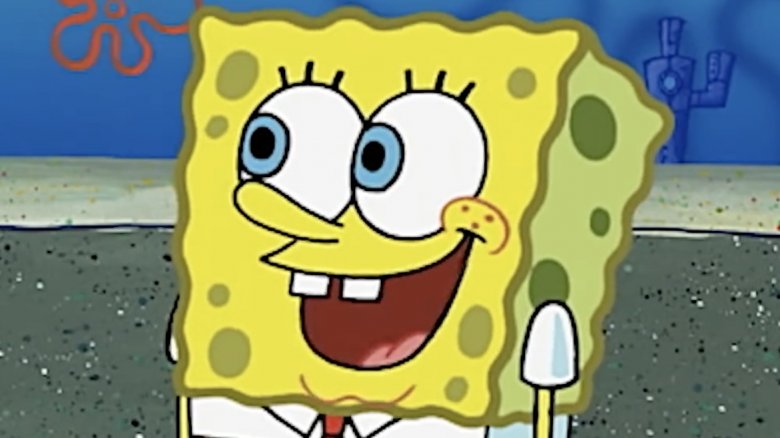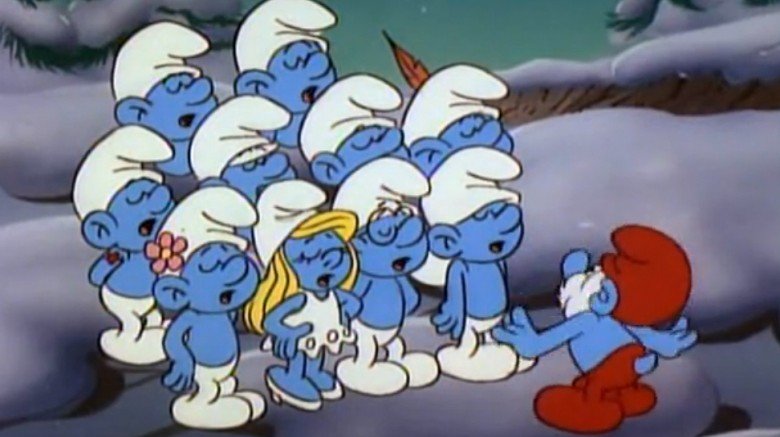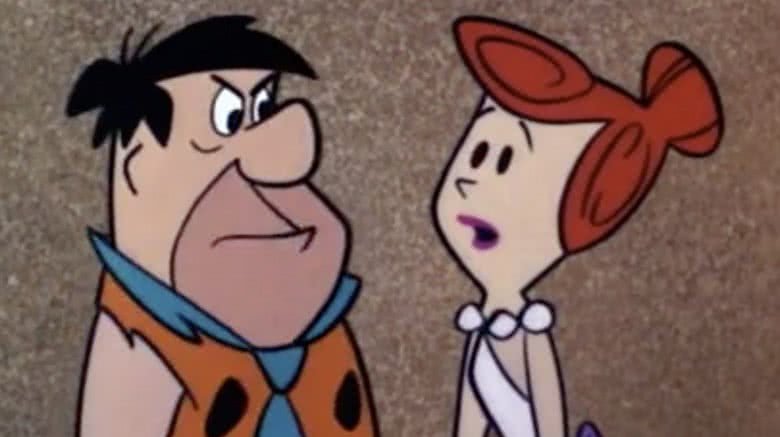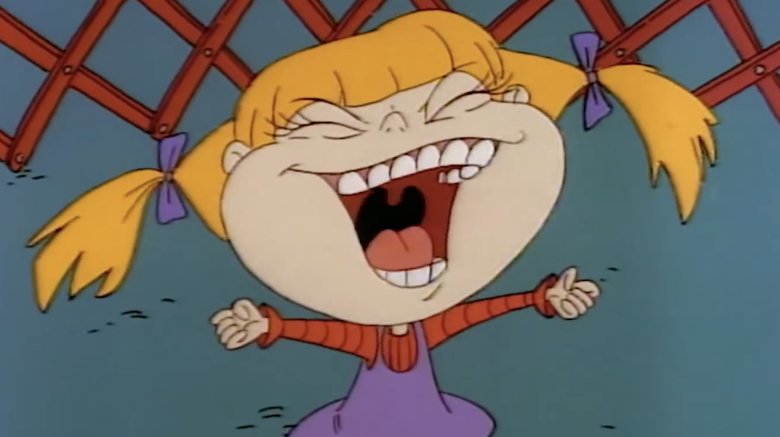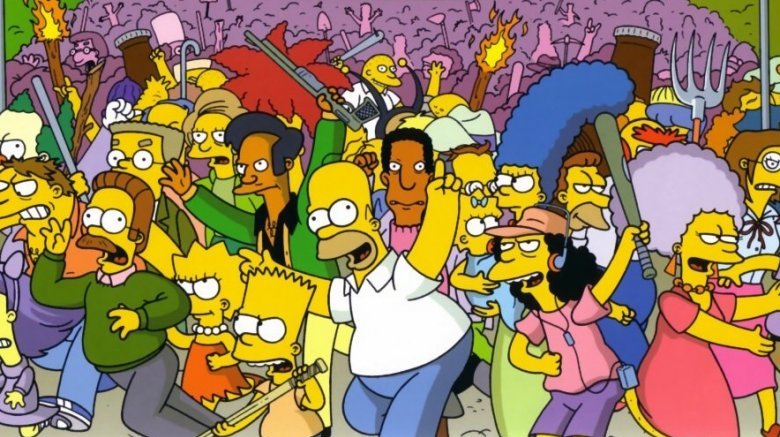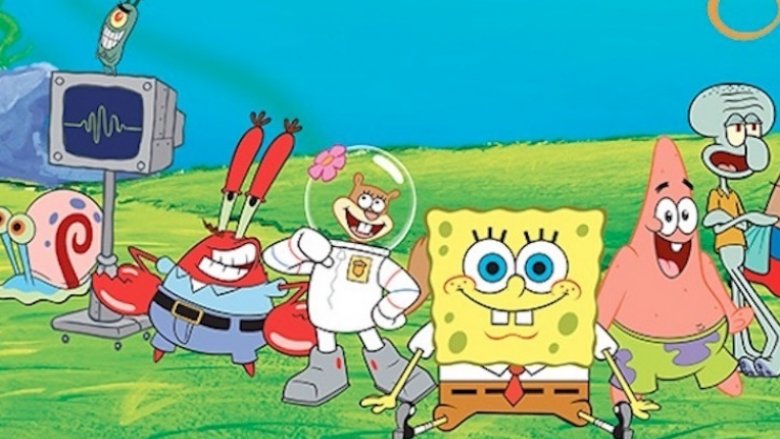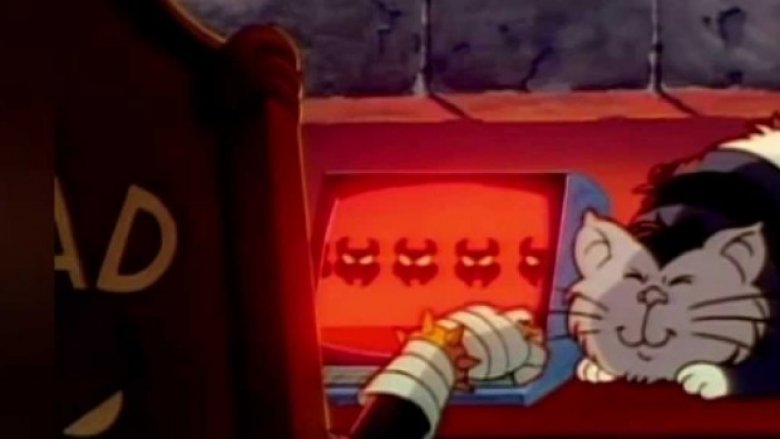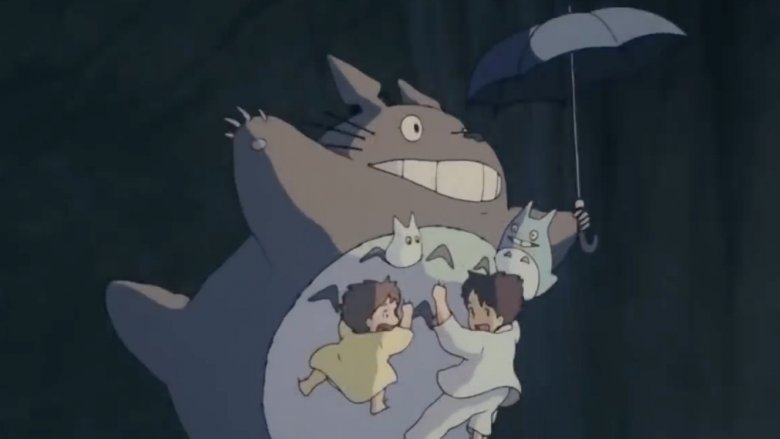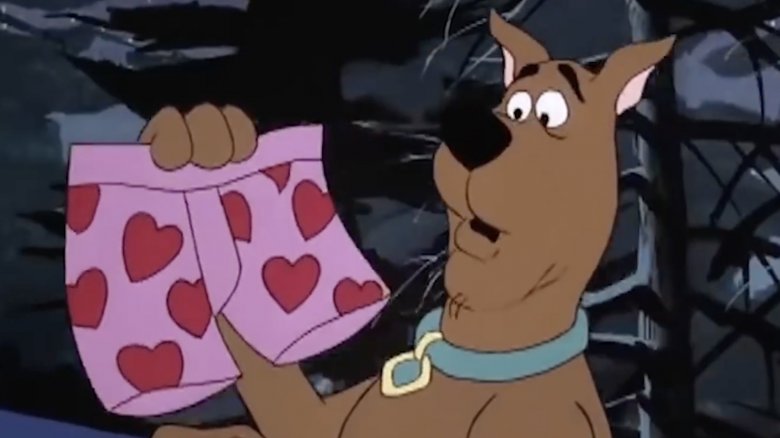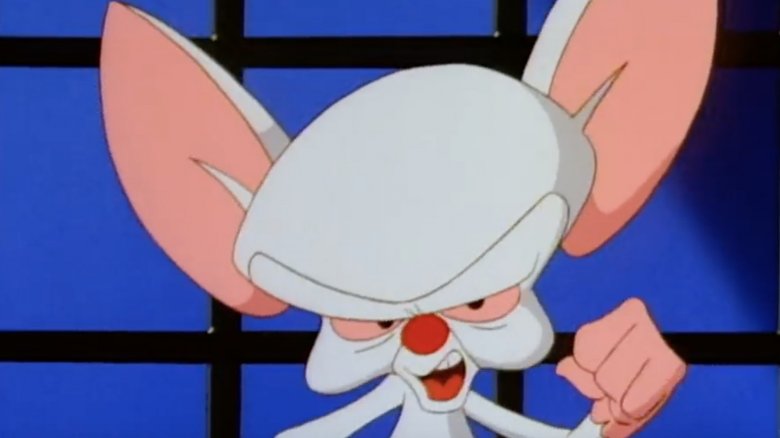The Most Bizarre Classic Cartoon Fan Theories
Fan theories are probably most often conceived and perpetuated by people who don't understand how TV shows and movies are produced. Writers work under tremendous deadlines and have to compose a script with an engaging and coherent plot that's true to a show's characters — and that's it. To carefully lace a show with deep conspiracies or pitch-black subtext just isn't practical. Also, these are talented writers. If they wanted some crazy undercurrent to exist, they'd write it...and win Emmys and critical praise for it, rather than make it so secret that only intrepid internet sleuths could figure it out.
That said, fan theories can also be a lot of fun. They add an extra element to a show that audiences know through and through, and they can be a great way to apply those analytical skills learned in high school English. With that in mind, here's a look at some of the most bonkers fan theories that have circulated about innocent (or are they?) classic cartoon shows.
The Smurfs should be red not blue
After enjoying popularity as a European comic strip for decades, the Smurfs became an American pop culture sensation in the 1980s. And contrary to the down-with-Communism, up-with-materialism sensibility of the decade, the Smurfs all worked not for personal wealth accumulation, but for the betterment of Smurf Village, each knowing their place and carrying that assigned task as their own name. For example, Brainy Smurf solved problems because he was smart, and Brawny Smurf could lift heavy stuff because he was so strong.
In 2011, French sociologist Antoine Buéno suggested in The Little Blue Book that the Smurfverse was "steeped in Stalinism and Nazism," as their leader Papa Smurf demonstrated "authoritarian and paternalistic characteristics," like some kind of fascist. Smurfs don't own property and have a collective economy, a la socialism or Communism. As far as the Nazi similarities go, Bueno noted that Smurfette, with her long blonde hair and small nose is the "Aryan ideal of beauty," and that the villain, Gargamel, "is ugly, dirty, with a hooked nose who is fascinated by gold" — all negative stereotypes of Jewish people.
Unsurprisingly, the Smurfs' creator, the Belgian artist known simply as Peyo, took issue with this. "I disagree with his interpretation," he retorted. "It is between the grotesque and the not serious."
The Flintstones are the sad Jetsons
The Flintstones takes place thousands of years in the past, and yet the day-to-day details of the characters' lives seem to come straight out of the 1960s culture that birthed the show. For example, Fred Flintstone and Barney Rubble go to their lodge meetings and love bowling, leaving their wives, Wilma and Betty, at home to tend to the house with the help of appliances powered not by electricity but wisecracking animals. Of course, they might all pile in Fred's foot-powered car, and go out and see the new Ann-Margrock movie, or another movie starring another 20th century celebrity with a stone-or-rock-based pun name. One could call all of this creative license, or a fun away of setting a modern sitcom in the past. Or maybe something darker is afoot — maybe, as some have suggested, The Flintstones contains so many remnants of 20th century culture and technology because it takes place in the distant future rather than the distant past. One piece of "proof" from WatchPlayRead: Bam-Bam's superhuman strength and his white hair are the result of mutation from radiation triggered by nuclear fallout...from the same atomic war that destroyed modern life as we know it.
Winnie the Pooh and a clinical diagnosis, too
British author A.A. Mline's stories about Christopher Robin and his animal friends — Pooh, Tigger, Eeyore, etc. — and Disney's many wildly popular adaptations are among the sweetest, most gentle, and beloved children's entertainment of all time. And, if one psychology-minded read is correct, it's also a Diagnostic and Statistical Manual of Mental Disorders for kids. Yes, The Many Adventures of Winnie the Pooh should more accurately be titled A Children's Garden of Common Mental Illnesses.
According to a study first published in the Canadian Medical Association Journal, each of the main characters who live deep in the Hundred Acre Woods exhibit traits of a different mental health issue. Winnie the Pooh, who obsessively collects and eats honey all day, has an eating disorder. Eeyore is clearly depressed. Piglet's fear of everything is indicative of an anxiety disorder. Rabbit is so fastidious as to warrant an obsessive-compulsive diagnosis. The bounding, boundless Tigger has ADHD.
Furthermore, all of these animals are a figment in the imagination of Christopher Robin, suggesting that he's projecting all of his issues onto his imaginary friends — in other words, he has an eating disorder, anxiety, depression, OCD, and ADHD.
Oh baby, this one is dark
Rugrats was a low-key and adorable show. Essentially The Secret Lives of Pets but with babies, the plots concerned a group of infants and toddlers who hung out together because their parents were friends, and they tried to navigate and understand the perplexing world for which they had zero frame of reference. Tommy was their fearless leader, Chuckie perpetually afraid, and twins Phil and Lil were always fighting. Their nemesis: Tommy's older sister Angelica, a selfish, jealous handful of a child who liked to scare those babies just for kicks. One fan interpretation holds that Angelica has a good reason for her bad attitude.
According to this theory that made the rounds in 2013, every one of those babies, or "rugrats," is but a figment of Angelica's young imagination in coping mode. Chucky's mother died in childbirth, and so did Chucky, which explains why Chucky's dad was fearful and anxious. Tommy actually died in utero, and that's why she and Angelica's dad are always in the basement, sadly building toys for the son he never got to meet. Angelica had heard that Phil and Lil's mother was pregnant, but the pregnancy terminated, and since Angelica wouldn't have known the gender of the child, she went with both.
The Simpsons really will last forever
After more than 30 years on television, the basics of life haven't changed all that much for the Simpson family on The Simpsons. Bart Simpson is still 10, Maggie is still a baby, and Homer and Marge are high school sweethearts pushing 40. Also unchanged after all that time is one of the show's most elaborate and famous running jokes — the mystery of where, exactly, the show's setting of Springfield sits.
The Simpsons can get away with those things because it's a cartoon — the characters don't have to age. And Springfield is supposed to have the feel of any generic, medium-sized town, located everywhere and nowhere all at once. (It's in a state that impossibly borders Ohio, Nevada, Maine, and Kentucky.) But those logical explanations aren't nearly as fun as the idea that Springfield sits in a "space-warping tesseract." Taking the many Simpsons geography jokes at their word, one theorist says that this is how West Springfield can be three times the size of Texas, or how some landmarks come and go, like the mansion across the street from the Simpsons where President George Bush briefly lived. That tesseract also means Springfield is stuck in a "time loop," which is why nobody ever ages.
If nuclear nonsense be something you wish
Who lives in a pineapple under the sea? SpongeBob Squarepants. But where, specifically, under the sea, does the porous and yellow Krusty Krab cook call his home, along with Patrick Star, Squidward, Plankton, and Sandy? Well, Bikini Bottom, of course. At first mention, the name of that fictional seafloor town is a mildly racy joke that parents are more likely to pick up than kiddie viewers — it's the name of half of a swimsuit, of course.
Fashion designer Louis Réard introduced the first modern two-piece swimming garment in 1946, and he named it the bikini, after Bikini Atoll, the tiny Pacific Ocean locale where the U.S. conducted its nuclear weapons tests. It stands to reason that underneath Bikini Atoll sits Bikini Bottom, and that the high concentration of radiation and nuclear fallout could mutate any and all life in the vicinity. It might result in, say, a talking sponge, or a nice but stupid starfish, or a clarinet-playing octopus.
Go, Go, Gadget, go away
'80s kids loved Inspector Gadget, despite its predictable, never-changing formula. "Chief" gave the cyborgian titular gumshoe an assignment (and got blown up by the self-destructing printed message), and then the bumbling Gadget went all over the world to catch another agent of the evil Dr. Claw...although he was so incompetent that Gadget's niece Penny actually solved the case with the aid of her computerized book and Brain, her hyper-intelligent dog. Then the deep, almost unnaturally-voiced Dr. Claw would shout "I'll get you next time, Gadget!" and the credits rolled. All the while, Dr. Claw's face was never revealed, only an arm and hand covered in (or made of) metal, often stroking his cat.
According to one theory, here's why Dr. Claw's face was never revealed in the cartoon series: He was the first Inspector Gadget. He was horribly disfigured in an accident and thought to be dead, leading his grieving genius niece Penny to rebuild her uncle in robot form. (Yeah, he's a robot, not a cyborg.) Meanwhile, the real Inspector Gadget actually lived on, and he devoted his life to stopping that robotic imposter. Go Gadget, go?
My Neighbor the Angel of Death
My Neighbor Totoro is one of several masterpieces in the canon of legendary animator Hayao Miyazaki and his company, Studio Ghibli. Set primarily in rural Japan in 1958, it's about two young sisters who, in the midst of dealing with their mother's prolonged illness, hang out with a magical, fluffy, deep-voiced forest monster named Totoro. He introduces Satsuki and Mei to his world of wonder and proves a nice distraction from reality — a reality that, according to a fan theory, is comprised of doom.
Under this idea, Totoro isn't a nice "neighbor" at all, but actually an angel of death whose arrival heralds the imminent death of anyone unfortunate enough to see him. The "evidence" that Satsuki and Mei die soon after they meet Totoro? The girls don't have shadows, and the "Cat Bus" (literally a giant cat that serves as a bus) leads the girls to the realm of the dead.
Scooby-Dooby Da
Scooby-Doo and those meddling kids in Mysteries Incorporated have never been off TV for long over the past 50 years. The first Scooby-Doo show, Scooby-Doo, Where Are You?, combined spooky stuff with wacky comedy fueled by the titular Great Dane who could inexplicably speak English. Scooby-Doo never explained how a dog could talk, but Reddit user themightyheptagon has a theory: The Russians did it.
Scooby-Doo, Where Are You? debuted in 1969, a big year for the space race, what with American astronauts landing on the moon. They got there before the Soviet Union's cosmonauts did, although they got a jump by launching Sputnik in 1957 and sending Yuri Gagarin on the first manned space flight in 1961. The U.S.S.R. also sent a ton of dogs into space, notably some pups named Laika, Belka, and Strelka. This fan theory contends that Scooby-Doo was a result of the next logical step of the Soviets' dogs-in-space program: breeding hyper-intelligent dogs that could pilot spaceships. Scooby-Doo, however, turned out too well, so smart that he learned to talk like a person. Then a Russian scientist working in the program defected to the U.S., and he took Scooby with him. When the guy died of old age, Scooby ran away and met Shaggy.
That's called using your Brain
There's some prominent darkness on the surface of Pinky and the Brain, let alone the stuff people have seen hiding in the subtext. The main characters are laboratory mice, meaning that when they aren't trying to "take over the world" at the Brain's behest, they're getting experimented on in all kinds of ghastly ways. But this is a kids' cartoon, so it's primarily about the two polar opposite characters — as the theme song reports, "one is a genius, the other's insane." Viewers assume that the Brain is the genius — his name is the Brain, after all, and he's always hatching elaborate schemes while Pinky bounces around and says "narf!" a lot. But listen closely to the theme song. Pinky is introduced first, and then the Brain. Then the lyrics say one is a genius, and the other is insane. Those adjectives correspond back to Pinky, and the Brain. According to a fan theory, it's Pinky who's the genius, while the Brain is insane. It kind of makes sense — Pinky might just pretending to be dumb so he can quietly foil would-be-deranged-supervillain the Brain in his schemes, week after week.
